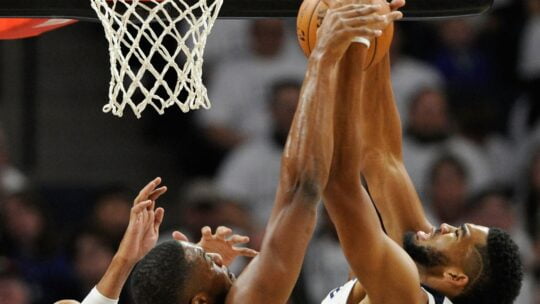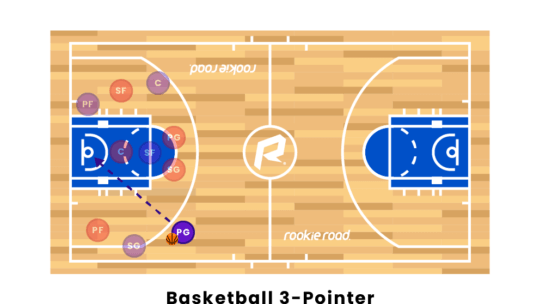What Is Defensive Rebound In Basketball?
It helps to have a size in the sport of basketball. I have had the luxury of coaching size with talent, speed, and heart. Those teams won a lot of games. I have also had the luxury of coaching teams without size, much speed but lots of heart.
Those teams won a lot of games. One of my favourite teams of all time went 29-9, won an undefeated district title, advanced deep into the state playoffs and did not have a player over six feet tall, except our excellent but undersized 6’2″ centre.
The common wisdom of the sport says size matters, and it does when it comes to rebounding. You will win a lot of games with great rebounding. Or can you? It may require a considerable bit of rethinking of how you teach and coach the game as a coach, but it can be done.
Here are 8 Strategies for Defensive Rebounding to consider to help resolve your team’s defensive rebounding problems.
First, let me get a couple of things clear. Defensive rebounding matters and size is a factor. These ideas are a bit out of the box, but they will cause problems for the opponent if you, as a coach, teach these ideas, make them habits and stick with them.
There is no escaping the need to rebound defensively, and the idea is to reduce the problem to a manageable level if your team struggles with defensive rebounding.
- Number One:
Rely on turnovers instead of defensive rebounds. If the opponent does not get a chance to shoot the ball, you don’t have to worry about the defensive rebound. Consider a high-pressure defence designed to force a huge number of turnovers.
Half-court traps and pressure denial man-to-man with traps like the famed North Carolina Scramble defence are effective. Complete court trapping defences, zone or man-to-man, can be equally effective.
For small teams with speed and quickness, this is a fantastic approach. It has the advantage of attacking the opponent, forcing the opponent to react to what your team is doing, and not focusing on taking advantage of its size and rebounding strength.
- Number Two:
Encourage the 3-point shot in certain situations – long rebounds are like loose balls. If the opponent is an OK outside shooting team or a poor one, consider encouraging the 3-point shot. Play a defence that fiercely contests all interior shots, whether by penetration, cutting or feeding the post, but concedes the outside shot.
Missed 3-point shots take much longer rebounds, about half the distance from where the shot was taken. This reduces, to a degree, the size advantage of the larger team. The rebounds are more like loose balls than rebounds, making quickness to the ball as big an issue as size and position. If the opponent has one great shooter, they pressure that shooter and let the rest cast up long-range 3-point attempts all game long.
This tactic has to be practised, and the emphasis should be on being the first to the ball and either controlling it or deflecting it to an open area on the court where possession can be obtained. It should be combined with an overall emphasis on obtaining every loose ball.
- Number Three:
Consider adjusting your help side positioning. The closer your help defenders are to their defensive assignments, the quicker they can block out. In certain situations, this may render your defence a bit more vulnerable (well, there is no way about it), but you have to consider if the trade-off is worth the quicker block-out times.
- Number Four:
Send the point guard to the weak side or middle – the other team’s point guard will be getting back on defence or moving towards balancing the floor to prevent a fast break.
Let’s face it, how many point guards rebound? Nearly every team sends its point guard back to prevent the fast break.
This should allow your point guard to be a free, extra rebounder. Since 80% of missed shots rebound on the side of the goal opposite from the side, the shot was taken (can you believe someone charted that?), run the point guard to that side of the court. Not only will it provide you with an extra, gratis, unblocked rebounder, but this is also the quickest possible way to initiate a fast break.
- Number Five:
Pick who you block out – play percentages and flood the weak side with multiple rebounders. Some players are just not going to rebound well. When confronted with an exceptional rebounder, it might be an excellent strategy to find the one player, other than the point guard, who does not rebound effectively and not block that player out.
Use the defender ordinarily responsible for that player to double block out the gifted rebounder. Be sure to send the point guard into the area to improve the chances of obtaining the rebound.
- Number Six
Turn rebounds into loose balls – tip the ball into the short corner and run it down. Don’t slug it out with a heavy weight; you’ll lose. Try to tip the ball to the short corner, the area between the goal and the corner, near the baseline and behind the backboard.
By tipping the ball to a general area, your team will have a greater chance of running down the ball. If the opponent does secure the offensive rebound, it is a difficult location of the court to score from, requiring the opponent to set up their offence, giving your defence time to reset.
- Number Seven:
Fast break on every opportunity – teams stop crashing the offensive glass to get back. This may seem more like an offensive tactic, but it works, especially against deliberate teams. Opponents who fear the fast break are vulnerable to this tactic.

Deliberate teams heavily emphasise defensive transition to prevent the fast break, allowing them to control the game’s tempo and keep the pace slow; they will often concede the offensive rebound to make a defensive transition.
- Number Eight:
Emphasize obtaining the rebound more than blocking out. Heresy, I know. But as I said before size matters. In this case, the size of the rebounder’s heart is the level of desire to obtain the ball. The issue should never be how the ball is obtained but that possession is obtained legally, without fouling or turning the ball over.
To effectively use any or all of these concepts, they must be practised daily and emphasized. Remember, players, do not know what their coach teaches but what their coach emphasizes!
Related Post


